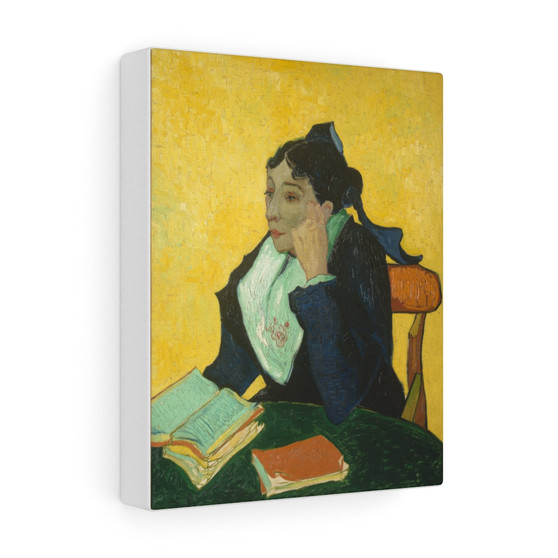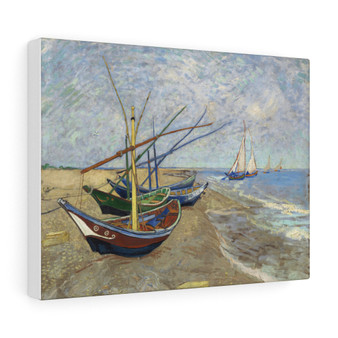Product Description
L'Arlésienne- Madame Joseph-Michel Ginoux (Marie Julien, 1848–1911), 1888–89, Vincent van Gogh, Dutch. Art by masters. Historical artwork in public domain. While in Arles, Van Gogh painted two very similar portraits of Marie Ginoux, the proprietress of the Café de la Gare, wearing the regional costume of the legendary dark-haired beauties of Arles. The first version, which he described in a letter of November 1888 as "an Arlésienne . . . knocked off in one hour," must be the more thinly and summarily executed portrait in the Musée d'Orsay, Paris. In it a parasol and gloves lie on the table instead of books. This portrait belonged to the sitter until she sold it in 1895. Title: L'Arlésienne: Madame Joseph-Michel Ginoux (Marie Julien, 1848–1911) Artist: Vincent van Gogh (Dutch, Zundert 1853–1890 Auvers-sur-Oise) Date: 1888–89 Marie Julien (1848–1911) married Joseph-Michel Ginoux (1836–1902) in 1866. Together they ran the Café de la Gare at 30, place Lamartine, in Arles. Van Gogh rented a room at the café from early May to mid-September 1888. There is another version of this portrait with an umbrella and gloves on the table, rather than books (F489; Musée d'Orsay, Paris). Van Gogh wrote a letter to his brother Theo around November 3, 1888 [Van Gogh Letters 1958, letter no. 559/Van Gogh Letters 2009, letter no. 717] describing a painting of an Arlésienne "knocked off in one hour." Later letters also mention a painting which must be either the New York or the Paris picture, but never mention two separate versions. Although the question cannot be resolved with certainty, most authors after Pickvance (1984) believe that the Paris picture was the first version, and thus the work referred to in the letters. For additional references see the following: Van Gogh Letters 1958, letter no. 573/Van Gogh Letters 2009, letter no. 741 [asks if Theo saw “the portrait in black and yellow of Mme Ginoux” during his visit to Arles, and states “that’s a portrait painted in 3 quarters of an hour”]; Van Gogh Letters 1958, letter no. 589/Van Gogh Letters 2009, letter no. 767 [states that he recently sent to Theo two crates of canvases (probably including a version of “L’Arlésienne)]; Van Gogh Letters 1958, letter no. 590/Van Gogh Letters 2009, letter no. 768 [possibly referring to portraits of Mme Roulin and Mme Ginoux among a batch of canvases he had just sent to Theo, states that “you’ll clearly see that the two women’s expressions are different from the expressions one sees in Paris”]; Van Gogh Letters 1958, letter no. T10/Van Gogh Letters 2009, letter no. 781 [writes that he likes the “vertical figure of a woman” and adds that it was admired by “a fellow here named Polack who knows Spain and the paintings there well. He said that it was as beautiful as one of the great Spaniards”]; Van Gogh Letters 1958, letter no. 595/Van Gogh Letters 2009, letter no. 782 [in response to Theo’s letter (see preceding ref.), writes that he is glad to hear that “there was another who found something in the yellow and black figure of a woman”]; Van Gogh Letters 1958, letter no. 625/Van Gogh Letters 2009, letter no. 850 [writes that he is anxious for an ill woman friend “whose portrait I did in yellow and black”] Van Gogh painted four other portraits of Madame Ginoux (F540–43), all based on a drawing by Paul Gauguin (Fine Arts Museums of San Francisco). Designed for indoor use, custom stretched canvas prints are made from treated cotton - providing the smoothest of matte surfaces for exceptional design vividity. A combination of quality and durability, these hangings come with a lifelong color guarantee; there's significant confidence in their withstanding the test of time. On the backside, pre-installed hanging hardware ensures proper locking to walls. .: 100% cotton fabric .: Wooden frame .: High image quality and detail .: For indoor use














